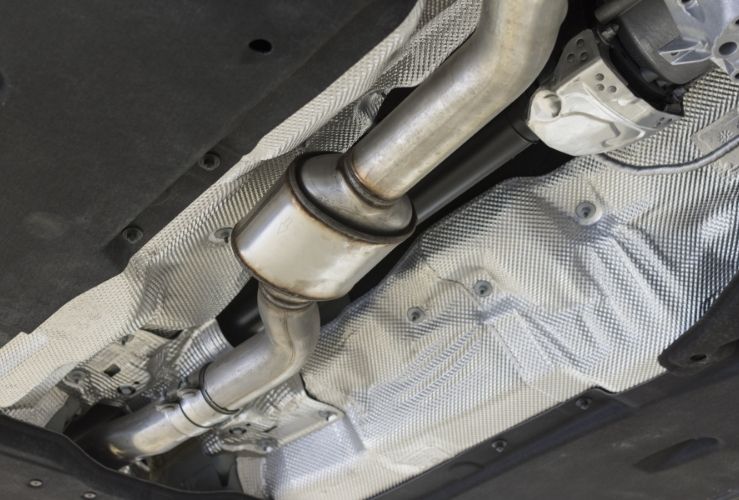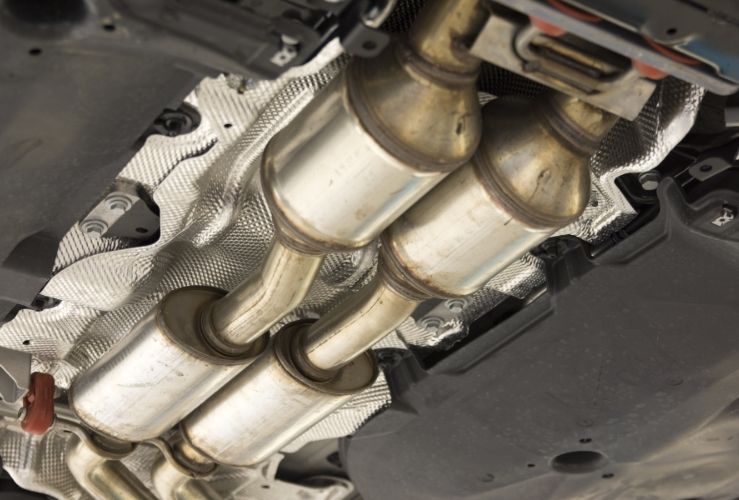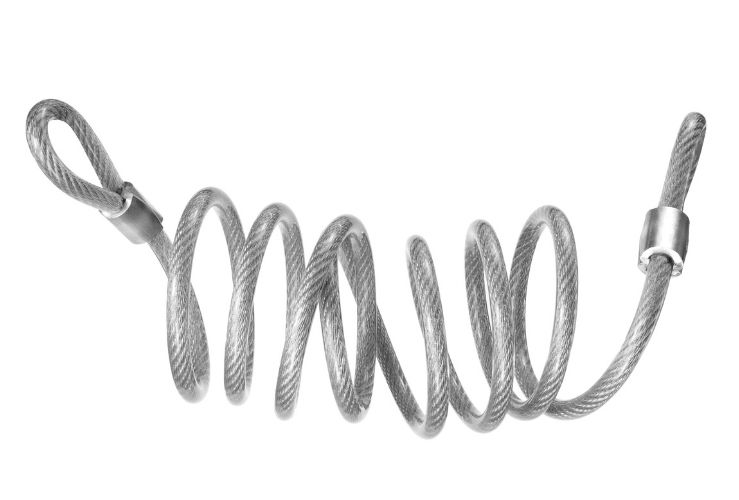NB: This blog is for informational purposes only. It doesn't constitute advice. Attempting any of the approaches described below to prevent catalytic converter theft is done at your own risk.
Catalytic converters have been around since the 1970s and transform harmful emissions into safer gases - such as steam.
Found on petrol, diesel and hybrid cars, catalytic converters are often targeted by criminals,
In a FOI request made by OPAL and Sky News, data showed that in 12 months from December 2021, criminals stole 28,000 catalytic converters.
Why do thieves target catalytic converters?
Catalytic converters are targeted by thieves because they contain rare metals - essential for the converter to work - that are more valuable than gold and which can be sold on with ease.
Stolen catalytic converters rarely find their way back into another car.

The palladium found in catalytic converters is particularly valuable. Platinum and rhodium are also present - and are also very valuable....
Thieves often target petrol-hybrid models - especially older models that are less likely to have converter cage or anti-theft device installed.
When carrying out catalytic converter thefts, criminals often audaciously pretend to be mechanics as they slide under cars in car parks or outside owner's homes. They then use an angle grinder to release the converter.
Which cars are targeted most for catalytic converter thefts?
Research from insurer Admiral revealed that the average claim for a catalytic converter theft is more than £1,500. And according to Admiral’s data, the most-targeted models are the Honda Jazz, Toyota Prius, Toyota Auris and Lexus RX.
Thieves tend to target hybrid vehicles more often due to the resale value of the catalytic converter from these vehicle types.
Because the combustion engine does not operate all the time, less heat is generated in a hybrid Less heat means the catalytic converter is not as efficient, so it needs more precious metal catalysts than required in a catalytic converter of a conventional vehicle..
These additional precious metals in a hybrid’s catalytic converter make them more valuable to thieves than the catalytic converters of conventional vehicles.
Vehicles that are higher off the road, such as SUV’s are often targeted also, because it’s easier for thieves to get under the car.

It doesn't take long to remove a catalytic converter. A would-be thief only has to shimmy under your car with an angle grinder, then locate the converter and cut it off at the exhaust pipes.
The three things a thief needs to get away with your cat:
- Cordless saw
- Access to both ends of the exhaust pipe
- Free space to drop the cat out - which there usually is
Therefore, limiting/removing access and/or space around the catalytic converter is a sure way how to stop catalytic converter theft
However, it should be noted that no device or system is 100% effective at preventing catalytic converter theft. If a criminal has the time, tools and space to operate, they will eventually get the cat. However, making it as difficult as possible will discourage them.

Top tips to prevent catalytic converter theft
There are some simple steps you can take in helping to prevent your catalytic converter from being stolen:
Try to park somewhere secure
Ideally, if you have a garage, park your car within this and ensure that you lock the garage. Else, if you have access to a driveway or other off-road parking, you should opt to use this. If none of these are an option, look to park as near to your home as possible, in a well-lit area. Thieves are deterred by vehicles parked in well-lit, highly visible areas - such as under lamp posts.
When parking away from home, aim to choose a car park that has been endorsed with the park Mark.
Park Mark status demonstrates a safer parking option, in that measures have been taken actively reduce crime. Over 4,500 UK carparks have been assessed under this police endorsed scheme.
Park near walls or fences to limit access
Parking near walls and fences can help restrict access to your catalytic converter.
Find out where your catalytic converter is located on your car; if it’s at the front of your car, park with the bonnet towards a wall if possible. If it’s at the back, park it with your exhaust to the wall.
Do not park with two wheels on the kerb
Parking with two wheels on the pavement and two on the road makes access to your car’s cat much easier.
As thieves need to get under a car to steal the catalytic converter, parking your car level will make gaining access a little harder for any would be cat converter thief.
Install an aftermarket vibration alarm
Thieves will often use a jack to improve access to the catalytic converter. By installing a vibration alarm on your car, should they tilt the car, setting the alarm off may deter the criminals from continuing their attempted cat theft.
Install front and rear dash cams
The presence of a dashcam may deter a would be thief from stealing your cat.
Note that if a group of thieves is moving through a neighbourhood, making your vehicle even a little more difficult to attack could compel them to move on to an easier target. This is particularly true if you add a physical deterrent, as detailed below.
Your catalytic converter may already be near theft-proof
In some cars, catalytic converters come directly off the exhaust manifold on the engine block, making them very difficult to cut off - i.e. there isn't enough space to get the angle grinder in place.
Check to see if your vehicle has a setup like this; or get your garage to check. If it does, adding anti-theft measures may not be necessary.

Here are some of the products designed to prevent or remedy catalytic converter theft:
Comprehensive insurance
The theft/vandalism component will recoup the cost of a stolen catalytic converter - minus any excess.
Along with the excess, downsides include the higher cost of comprehensive insurance, dealing with potentially higher premiums as a result of making a claim.
In short, relying on your insurance is arguably not the best move; you need preventative measures.
Can you get a catalytic converter lock?
A Cat loc (around £115) is a device specially designed to lock around the catalytic converter and prevent it from being stolen. However, they are not available for all makes and models.
If you have the tools available to bend, cut, and weld rebar you can create a DIY catalytic converter lock by fitting a rebar cage around your cat.
Cat clamp (£170+, depending on make and model)
A device that features cables that protect the catalytic converter.
Steel wire rope with clamps (£10)
This is one of the cheapest options for preventing your catalytic converter from being stolen, available from hardware stores from as little as £10.
Run the steel cable around the converter then hook the ends up to holes in the car's frame.
Skid plate/undertray (£30 - 40)
This is a sheet of metal designed to fit the underside of your vehicle. It will prevent thieves from accessing both ends of the pipe, thereby preventing them from cutting it out.
DIY skid plate (potentially no cost)
If you're handy with an angle grinder you might consider making a homemade version of a skid plate.
Shimmy under your vehicle and make a cardboard stencil stretching out to the rails, then cut the stencil out from a sheet of metal - e.g. from an old washing machine, fridge or car bonnet (ideally a non-rust material).
You would then bolt the plate onto the frame, cutting off access to the catalytic converter. This technique may even make your vehicle more aerodynamic!
Cage mesh (cost varies)
Welding a cage mesh to the underside of your vehicle is also an option. The “Do It Yourself” approach will of course be cheaper than paying someone.
All of these suggestions could be considered the best catalytic converter anti-theft device since they each add an additional layer of protection to deter thieves from stealing the cat.
How long for a thief to steal your cat?
Experienced thieves may be able to remove a catalytic converter in as little as two minutes.
How do I know my catalytic converter has been stolen?
The first sign your catalytic converter is stolen, is that your car will make a lot more noise than usual. Normally-quiet hybrids may make a rough, rumbling noise.
Inspection of the underside may reveal a missing catalytic converter.
What to do if my catalytic converter was stolen
If your car’s catalytic converter is stolen, you should report it to the police, providing them with as much information as possible.
The police should provide you with a crime reference number, which you will then be able to pass on to your insurer.
Depending on the level of cover you have in place, your insurer may be able to arrange for a replacement or reimburse you for any replacement of your catalytic converter.
You should not drive your car if your catalytic converter has been stolen. Driving without a catalytic converter is illegal, as your vehicle will produce emissions above the permitted standard. If you drive your car with the catalytic converter missing, you could face a fine from the police of up to £1,000 if caught, or £2,500 for a van.




